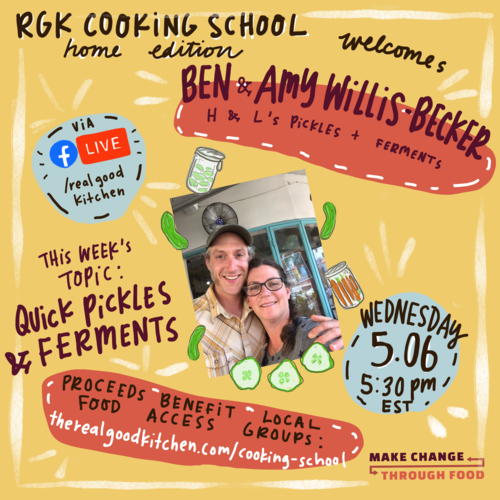Pickles with Ben & Amy Willis-Becker - RGK Cooking School Ep. 5
On this week’s episode of RGK Cooking School, we learn how to make hot and cold-brined pickles. The primary difference between the two methods is the vegetables you might use them on: hot brine is better for sturdier, dense vegetables, and cold-brine is better for more delicate or super thin vegetables.
If you missed the live recipe demonstration, you can watch it again on our Youtube channel.
Cold-Brine Pickles
Makes 2 Quarts:
2 cups vinegar (distilled white or rice works well with delicate vegetables)
2- 4 Tbsp sugar (depending on your taste)
1 Tbsp kosher or sea salt
Seasonings (about 2 Tbsp total)… like fennel seed, caraway, dill seed, fresh herbs…
Vegetables (About 2 lbs)… like fennel, cucumber, daikon radish, carrots…
Directions:
Place the vinegar, salt, and sugar in a pot and heat until the salt/sugar are dissolved. Chill the brine until it is ice cold.
Once cold shave the raw vegetables to your desired thickness and put directly into the ice cold brine. (The thicker the veg, the longer it will take to pickle.)
It is ready to eat now but letting it sit for at least 24 hours will make it much more flavorful and delicious. Pack in clean containers and store in the refrigerator, covered. Pickles will keep for several weeks.
Hot-Brine Pickles
Makes 2 Quarts:
2 c vinegar (distilled white, wine, sherry, apple cider)
2-4 Tbsp sugar (depending on your taste)
1 Tbsp kosher or sea salt
seasonings (about 2T total)… like pickling spice, chiles, juniper berries, ginger, turmeric, mustard seeds, peppercorns, bay leaves…
vegetables (2-4lbs depending on the vegetable)… like cucumbers, beets, cauliflower, onions, jalapeños, green tomatoes, turnips, sliced garlic (or a mix)…
Directions:
Place the vinegar, salt, and sugar in a pot and heat until the salt/sugar are dissolved. Once salt and sugar are dissolved add your seasonings, if using, and steep for 15 minutes.
While the brine is heating/steeping cut the vegetables into desired shape. Pack the vegetables in quart jars, leaving room at the top to cover with liquid.
Bring the brine back to a boil. If you are using more dense vegetables, you may want to add them to the brine and cook until they are as tender as you prefer. We like ours al dente. Remember there will be some carryover cooking once you take your pickles off the heat. (More tender vegetables, like cucumbers can be packed directly into quart jars and simply covered with the hot liquid.)
Store the pickles covered in the refrigerator. They will keep for several weeks.

